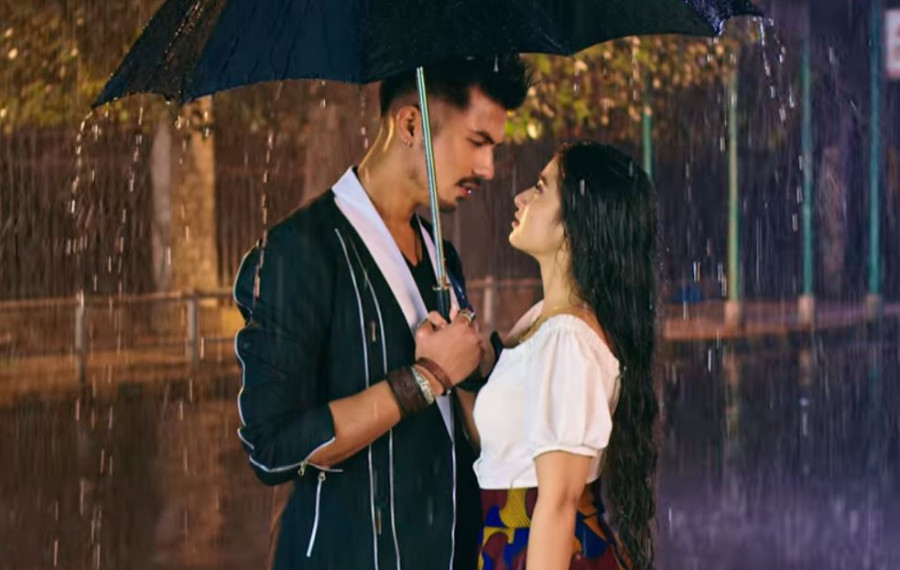Movies
Watch ‘A Mero Hajur 3’ if you like seeing Anmol KC do his thing. Otherwise, it’s a waste of time.
The basic plot of the film is unoriginal. Nepali filmmakers seem to believe that there is a formula for a romantic film with young people. First, titling your film like it’s a sequel, even though it has nothing to do with the other films in the franchise.
Abhimanyu Dixit
Ever wonder why Nepali commercial films almost never have subtitles? Both A Mero Hajur and its sequel are up on YouTube, but neither has subtitles. I’ve come up with two possible reasons why—the filmmakers either believe that non-Nepali speakers will never watch their films; or they are insecure about their films, as they have little to be proud of. If these films did have subtitles, the entire Nepali film fraternity would be ridiculed by viewers from around the world. So, I guess, we should be happy. By limiting their exposure, the A Mero Hajur team is preserving the global goodwill for Nepali cinema.
The first two A Mero Hajurs were commercially successful, and the third is still in theatres well into its third week. To really understand this series, I decided to watch the first two films. Sadly, my homework was absolutely unnecessary as this iteration is completely independent of the other two. And if you watch this film, you’ll realise that many of the film’s characters, storylines, sequences, and scenes are independent even of the film’s story.
Arya (Suhana Thapa) is a super fan. She glides around busy Kathmandu traffic, swooning over billboards of superstar Prem (Anmol KC), somehow also managing to take selfies. Now, although the effects team has done a fairly good job with the billboards, the production design team doesn’t seem to have cared less, using the same poster everywhere. In any case, Arya swoons. She has two friends—the somber Pinki (Rupa Ghising) and Moti (Rakshya Gautam), the most problematic character in the film, but more on her later.
Prem is a superstar singer who walks around with an entourage of bodyguards. Although I’d like to talk more about the character, Anmol KC and the filmmakers won’t let me. Because Prem is Anmol KC, with the same expressions, speech pattern and even the same tattoos. For those who’ve been paying attention, this is the defining trait of all Anmol KC characters.
Moving on, after Prem wraps up his concerts and the bodyguards go home, he puts on a lousy wig, some ill-fitting clothes, and becomes Ghanashyam—a shabbier version of Anmol KC. Prem is apparently also in love with Arya, because before he was a star, he was performing at a restaurant and she had happened to hear him, and had wished for him to become a superstar. Since Arya is obsessed with Prem and Prem has long been in love with Arya, what exactly is the problem? Prem wants to win over Arya as Ghanashyam, a common man. How very original!
After a slew of clichéd meet-ups, bad jokes, and utterly disgusting double entendres, Prem and Arya get closer. We are never told when or how Prem forgoes his original intent, as in a random scene, he proposes to Arya as Prem, not Ghanashyam. But that doesn’t seem to matter, much like everything else. A few predictable plot twists later, a hospital scene closes the film.

The film’s story is written by Suman Poudel and Jharana Thapa, the latter also the director of the film. There are four script and dialogue writers—Chetan Gurung, Baburam Dahal, Suman Poudel, and Pratick Poudel. Six people in the writing department might be rare for a Nepali film, but in this film, it’s a recipe for disaster. The old adage is true—too many cooks do spoil the broth.
The writers have gotten their basics wrong. First, the character arc for Samrat Narsingh Rana (Arpan Thapa) is poorly designed. He is established as Prem’s greedy brother-manager, who slaps people around to impress his authority. In the second act, he threatens and controls Prem to the extent that he isn’t allowed friends or lovers. But then, in the third act, Rana turns over a new leaf and encourages Prem to do what he will. There is nothing that happens in the film to effect this change. The scene is reminiscent of Amrish Puri in the ‘Ja Simran ja’ scene from Dilwale dulhaniya le jayenge. The audience is left scratching their heads.
And now to Moti, the most problematic character in the film. Moti, either by design or by accident, is initially annoying and sexually perverse. She says that a girl has to protect her ‘chaati and thigh’ (chest and thigh) and ‘thutuno and mutuno’ (mouth and genitals). She has a fetish for lewd signs and cannot stop thinking about the size of a penis she’s seen. Then, again, with no reason whatsoever, she stops being perverse. Do characters not need purpose anymore?
Are you a good writer if you derive laughs from fart jokes but pay no attention to what impact these seemingly careless jokes might have on the thousands of young minds in theatres and online? And because the film has a bunch of young writers, you can’t help but worry about the future of Nepali cinema.
The basic plot of the film is unoriginal. Nepali filmmakers seem to believe that there is a formula for a romantic film with young people. First, titling your film like it’s a sequel, even though it has nothing to do with the other films in the franchise. Second, inserting cheap, unoriginal jokes to derive easy laughs. Third, ripping off the primary plot points from South Korean romance films of the early 2000s, where one character dies owing to a terrible disease. And fourth, modeling your film around the aesthetic of a Bollywood musical.
If done right, a Korean romance can be an emotional rollercoaster. Scenes build characters in their story, and consequently, their characters build trust with the audience. You feel for these characters because they have been well written, because you get to know them. But A Mero Hajur 3 blatantly disregards the audience and logic, and even character building. There are so many characters on screen, but everyone is a caricature—not one is well-rounded, not one is complex.
The last act of the film is testament to the fact that no thought has been given to the writing. Something happens that will potentially change everyone in the film, and the audience is supposed to be heartbroken. But the way it’s written, the news is casually announced and the reaction we see is people crying. Everyone is crying and they’re doing so much of it that the audience isn’t. There is a fundamental problem with your film if the audience has no reaction, even when all your characters are crying.
A Mero Hajur 3 is a complete waste of time. Go watch the film if you like seeing Anmol KC do his thing, which is the same thing he does in all of his films. There is, however, one positive aspect—the mother-daughter duo of Jharana and Suhana Thapa.
The producers are Suhana Entertainment and Sunil Kumar Thapa, and no compromises have been made where expenses are concerned. Suhana looks comfortable with what she’s been assigned, but we don’t know if that’s because her namesake is producing the film or her mother is calling action. Credit where it’s due, she does manage to derive a few smirks. She beams with confidence and is the most watchable
character in the film. But again, she never gets the attention she deserves and there is only so much an actor can do with a badly written character.
The film could have been so much more than another Anmol KC film that came and went. The film will probably make some money, but no memories will be made.




 5.39°C Kathmandu
5.39°C Kathmandu












